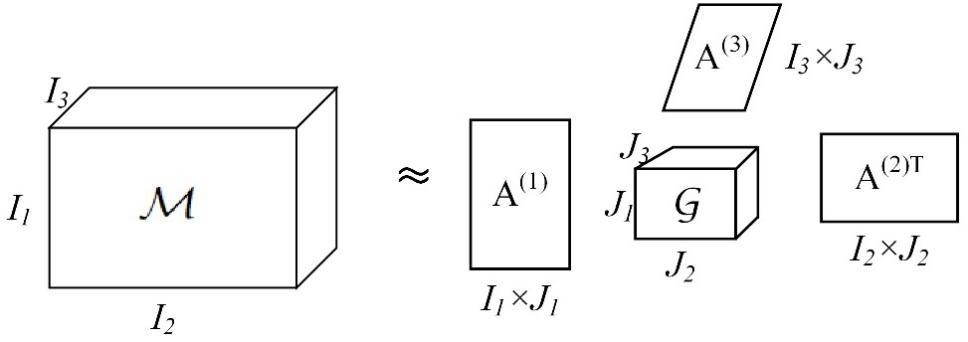A tensor is a multidimensional array that can be seen as an extension of a matrix in high dimensions (Kolda et al. 2009). In this research, the Tucker decomposition model under nonnegative constraints is used to process the third-order origin and destination tensors of shared bicycles.
The purpose of the Tucker decomposition model is to decompose n-dimensional tensorM∈RI1xI2x...xIninto a n-dimensional core tensorG∈RJ1xJ2x...xJn. Factor matrices can be thought of as the principal components in each dimension of the tensor, and core tensor shows the level of interaction between the different components (Khoromskij et al. 2007). Taking a three-dimensional tensor as an example, the schematic diagram of Tucker decomposition model is shown in Figure 1. The three-dimensional tensorM∈RI1xI2xI3is decomposed into a core tensorG∈RJ1xJ2xJ3and three factor matricesA(1)∈RI1xJ1,A(2)∈RI2xJ2,A(3)∈RI3xJ3. The formula of Tucker decomposition is shown in equation (1).

Figure 1. Illustration of the Tucker decomposition model (Cichocki et al. 2015)
M≅G x 1A(1) x 2A(2) x 3A(3)················(1)
Where is a three-dimensional tensor; is a three-dimensional core tensor;A(1),A(2) andA(3)are three factor matrices.
Each dimension represents a sort of pattern, three patterns can be found after tensor decomposition. The following figure (Figure 2) is the flow chart of Tensor Decomposition.
Figure 2. Flow chart of Tensor Decomposition
Reference:
DeMaio, P. (2009). Bike-sharing: History, impacts, models of provision, and future. Journal of public transportation, 12(4), 3.
Banerjee, S., & Roy, A. (2014). Linear algebra and matrix analysis for statistics. New York: Chapman and Hall/CRC.
Kolda, T. G., and Bader, B. W. 2009. Tensor decompositions and applications. SIAM review, 51(3), 455-500.
Khoromskij, B., and Khoromskaia, V. 2007. Low rank Tucker-type tensor approximation to classical potentials. Open Mathematics, 5(3), 523-550.










